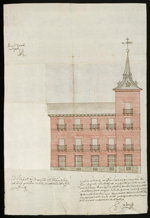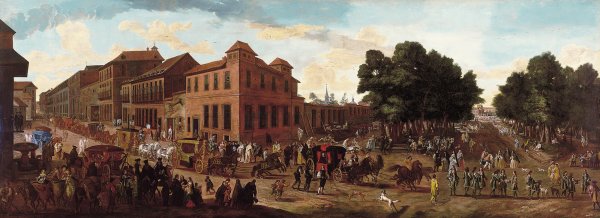The site until the middle of the 18th century
The Museo Nacional Thyssen-Bornemisza is housed in the Villahermosa palace, one of the finest examples of Madrid’s palatial architecture. Located on the Paseo del Prado, the main axis of the city’s new late-eighteenth-century extension, the palace witnessed major events in nineteenth-century history. But even before it was built – between 1805 and 1807 – the site on which it stands, a short distance away from the Buen Retiro palace, had already enjoyed prominence as one of the most important showcases of urban life, regularly crossed by royal processions and carriages. The history of this area of the city dates back to the sixteenth century.
Earliest references to the site
During the last third of the sixteenth century, after Philip II (1527−1598) decided to move the court to Madrid permanently in 1561, the city rapidly expanded eastwards. In 1569, the monarch had ‘royal quarters’ built next to the east end of the church of San Jerónimo el Real (1503−5) in which to spend periods of mourning and penitence, as well as the Lenten season. The following year he gave orders for improvements to be made to the Prado Viejo – now the Paseo del Prado.
Within a short time, the city had expanded in the directions of the roads leading to Alcalá de Henares (Calle de Alcalá), San Jerónimo el Real (Calle de San Jerónimo) and the hermitage of Atocha (Calle de Atocha). The first rural buildings with orchards and gardens were constructed around the Prado Viejo at the end of the century. Some were the residences of Italian families, such as the Spínolas, who acquired land next to the convent of the Espíritu Santo (now the Congress building).
However, the leading role in the expansion towards this part of the city was soon played by the principal aristocratic families. For example, in 1602, the Duke of Lerma (1553−1625), well aware of the monarch’s fondness for San Jerónimo el Real as a place of retreat, bought property between the Carrera de San Jerónimo, the so-called Prado de Atocha and the Calle de Huertas. He had the first buildings erected on the site of what would later, after passing by inheritance to his descendants related by marriage to the Medinaceli family, be known as the Medinaceli palace – now the Palace Hotel. But before that, in the first decades of the seventeenth century, the duke did not hesitate to invite Philip III (1578−1621) and his family to the summer celebrations he held there.
On the other side of the Carrera de San Jerónimo – facing what was then known as the Prado de San Jerónimo – the plots of land that later became part of the Museo Thyssen were acquired by the Duke of Lerma’s protégé, Pedro Franqueza, 1st Count of Villalonga (1547−1614), who served for years as finance minister to Philip III. He was accused of undue enrichment in 1607, and his properties were confiscated and sold off in lots. Soon afterwards the property on the corner of the Carrera de San Jerónimo and the Prado de San Jerónimo came to be owned by Luis Sánchez García, secretary of the council of the Inquisition. Other lots on the Carrera de San Jerónimo were bought by a dyer named Francisco and the licentiate Gregorio López Madera. Pedro de Porres y Vozmediano purchased the houses adjacent to the Calle de los Jardines, now the Calle del Marqués de Cubas.
The plots that had belonged to the Count of Villalonga further north, consisting mainly of orchards and gardens, were purchased between 1625 and 1628 by Jorge de Cárdenas, 4th Duke of Maqueda and 6th Duke of Nájera (around 1592−1644). In 1626, other land adjacent to the Calle de Alcalá (where the Bank of Spain now stands) passed to Manuel de Acevedo y Zúñiga, 6th Count of Monterrey (1582/1583−1653). Acevedo commissioned the architect Juan Gómez de Mora (1586−1648) – the designer of Madrid’s Plaza Mayor – to remodel the old houses and build a gallery flanked by two towers overlooking the Paseo del Prado. Decades later, the palace of the Duke and Duchess of Béjar was built on this site.
Houses opposite the Buen Retiro palace
In 1629, at the suggestion of the Count-Duke of Olivares (1587−1645), Philip IV (1605−1665) decided to extend the ‘royal quarters’ beside the church of San Jerónimo with a view to the swearing-in ceremony of the Infante Baltasar Carlos (1629−1646) before the parliamentary assembly of Castile, which took place in 1632. The work was supervised by the count-duke himself. Enlisting the help of the Italian architect and decorator Giovanni Battista Crescenzi (1577−1635), he built new rooms for the queen, a garden, a cage for wild beasts and an aviary.
The advantages of this location away from the city centre as a place for relaxation did not go unnoticed to Philip IV. Indeed, in 1632 he gave orders for the ‘royal quarters’ to be transformed into the Buen Retiro palace. Work began the following year and was completed in 1640. And although haste, the lack of an overall design and the precariousness of the materials used – chiefly bricks and mortar – gave the ensemble a disjointed appearance, the Buen Retiro palace soon turned the area into one of the noblest parts of Madrid.
Jaime Manuel Manrique de Lara y Cárdenas, 5th Duke of Maqueda and 7th Duke of Nájera (around 1585−1652), was well aware of this. After his father's death in 1644, he acquired the former property of the licentiate Gregorio López Madera in 1651. However, he was unable to buy the plot on the corner of the Carrera and the Prado de San Jerónimo. After lengthy family lawsuits, it passed into the hands of Diego de Silva, 7th Count of Galve (around 1640−1686), the third son of the Duke and Duchess of Pastrana and an author of burlesque plays. When the Duke of Maqueda and Nájera died, Diego de Silva bought the rest of the properties previously owned by the Count of Villalonga except for the plot on the corner of the Carrera de San Jerónimo and the Calle de los Jardines, which remained in the hands of the Vozmediano family.
On the corner of the Carrera de San Jerónimo and the Prado de San Jerónimo, Diego de Silva had a stately home built in the style established by Gómez de Mora. Later on, in 1679, he married Francisca María Manrique de Lara (around 1640−1705), daughter of the 1st Count of Frigiliana (1591−1654) and lady-in-waiting to the queen. When the 7th Count of Galve died in 1686 – the year View of the Carrera de San Jerónimo and Paseo del Prado with a Procession of Carriages, attributed to Jan van Kessel III (1654−1708), now in the museum’s lobby, was painted – the property passed to his widow. Following her death in 1705, the houses and estate went to her brother, Rodrigo Manuel Manrique de Lara, 10th Count of Aguilar and 2nd Count of Frigiliana (1638−1717).
Both the count and his son, Íñigo de la Cruz Manrique de Lara, 11th Count of Aguilar (1673−1733), played a prominent role in the War of the Spanish Succession as supporters of the cause of Philip V of Bourbon (1683−1746). Philip’s rival, Archduke Charles of Austria (1685−1740), entered Madrid in 1707 and 1710, and, according to the chronicles, on the second occasion he stayed on the ‘estate of the Count of Aguilar’ – possibly a reference to the property on the corner of the Carrera and the Prado de San Jerónimo. However, the archduke soon left Madrid, paving the way for Philip V’s return. Rodrigo Manuel retained his position as the latter's royal steward until his death.
When Íñigo de la Cruz died in 1733 and his widow passed away in 1736, their only heir was a distant female relative. She showed no interest in the properties on the Carrera and the Prado de San Jerónimo even though they came to enjoy a prime location in Madrid after the Alcázar was destroyed by fire (1734) and the court was moved to the Buen Retiro palace for thirty years. Their sale was announced in 1742, and did not take place until four years later.
The building of the Atri and Villhermosa palaces
- The Atri palace.
- The Villahermosa palace.

![Antonio Mancelli: La Villa de Madrid Corte de los Reyes Católicos de Espanna [hacia 1622] (detalle), estampa en Theatrum in quo visuntur illustriorum Hispaniae Urbis..., Ámsterdam, 1657. Biblioteca Nacional de España, Madrid Antonio Mancelli: La Villa de Madrid Corte de los Reyes Católicos de Espanna [hacia 1622] (detalle), estampa en Theatrum in quo visuntur illustriorum Hispaniae Urbis..., Ámsterdam, 1657. Biblioteca Nacional de España, Madrid](/sites/default/files/imagen/2021-09/Foto_01.jpg)

